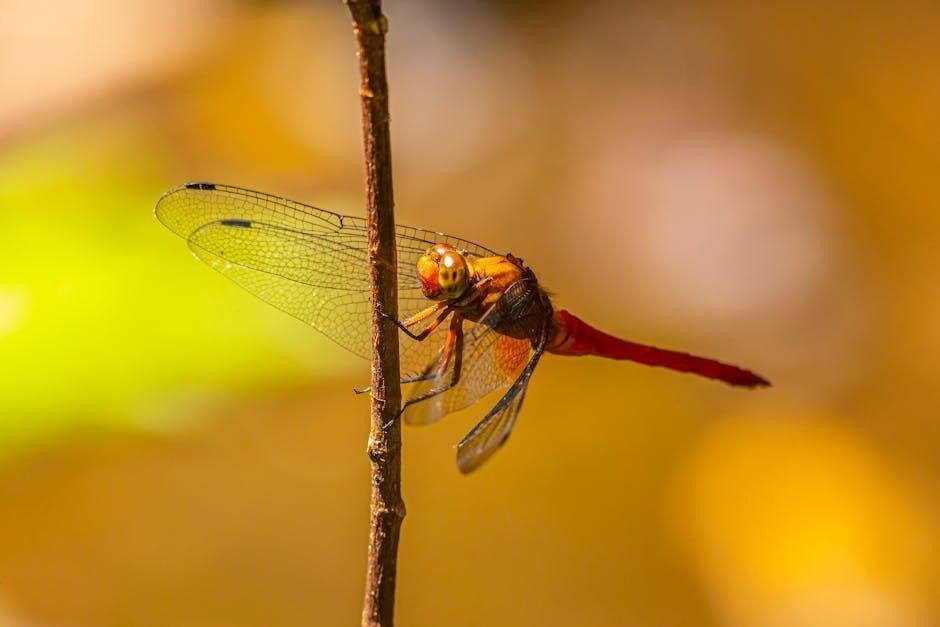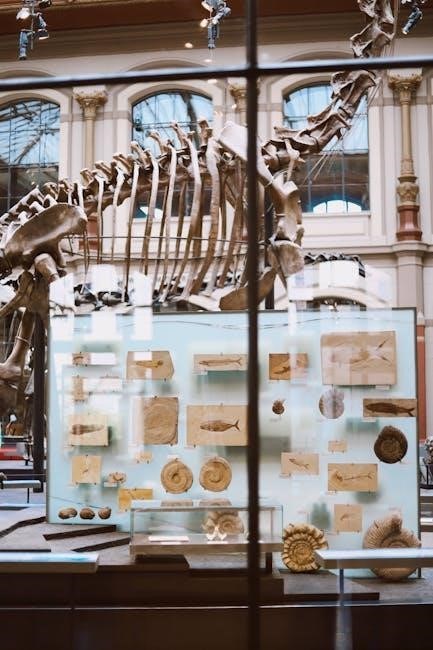Evolution is the study of life’s changes over time. It examines natural selection‚ genetic diversity‚ and adaptation‚ offering insights into life’s complexity and diversity on Earth.
1.1 Biological Evolution: Definition and Core Concepts
Biological evolution refers to the process of change in life forms over generations. It is defined as descent with inherited modification‚ where species evolve by passing genetic traits to offspring. This concept encompasses both small-scale changes‚ such as shifts in population genetics‚ and large-scale processes like speciation. Central to evolution is the idea that all living organisms share common ancestry‚ with diversity arising through mechanisms like mutation and natural selection. Genetic variation within populations provides the raw material for evolutionary changes‚ enabling adaptation to environmental challenges. Understanding these core concepts is essential for grasping the dynamics of life’s complexity and diversity on Earth. Evolution is a foundational principle in biology‚ shaping our understanding of ecosystems and species interactions.
1.2 The Importance of Studying Evolution in Biology
Studying evolution is crucial for understanding the diversity of life and how species adapt to environmental changes. It provides insights into ecological interactions‚ disease resistance‚ and human origins. Evolutionary principles are fundamental for medical advancements‚ agriculture‚ and conservation biology. By examining evolutionary processes‚ scientists can address pressing issues like antibiotic resistance and climate change. This knowledge also enhances our appreciation of Earth’s biodiversity and informs strategies for sustainable resource management. Evolutionary biology bridges biology‚ genetics‚ and ecology‚ offering a comprehensive framework for exploring life’s intricacies. It is essential for developing a deeper understanding of biological systems and their dynamic nature over time. Evolution’s study remains vital for advancing scientific knowledge and addressing real-world challenges.
1.3 Key Theories and Mechanisms in Evolutionary Biology
Evolutionary biology is rooted in several key theories and mechanisms. Darwin’s theory of evolution by natural selection explains how species adapt over generations through competition and environmental pressures. Genetic diversity‚ mutation‚ and genetic drift are central mechanisms driving evolutionary change. Overproduction of offspring ensures survival of the fittest‚ while reproduction passes inherited traits to future generations. These processes collectively shape biodiversity and species adaptation. Understanding these theories and mechanisms provides a foundation for exploring life’s complexity and change over time. They are essential for studying speciation‚ adaptation‚ and the dynamics of populations in ecological contexts. Evolutionary biology relies on these principles to explain the past‚ present‚ and future of life on Earth.

Core Mechanisms of Evolution
Evolution’s core mechanisms include mutation‚ genetic variation‚ and environmental pressures. These processes drive evolutionary change‚ shaping species’ traits and biodiversity over generations through natural selection.
2.1 Natural Selection: Principles and Processes
Natural selection is a fundamental mechanism of evolution where organisms with advantageous traits are more likely to survive and reproduce. This process drives adaptation‚ favoring specific traits that enhance survival in changing environments. Over time‚ these traits become more common in populations‚ leading to evolutionary changes. For example‚ in populations of finches‚ beak shape variations that allow better access to food sources during scarcity are favored‚ illustrating how environmental pressures shape species traits. Natural selection acts on genetic variation‚ ensuring that beneficial characteristics are passed to future generations‚ thus playing a crucial role in biodiversity and species resilience.
2.2 Genetic Diversity: Its Role in Evolution
Genetic diversity refers to the variety of genetic traits within a species‚ essential for its survival and adaptability. It arises from mutations‚ genetic recombination‚ and gene flow‚ providing the raw material for evolution. A diverse gene pool allows populations to respond to environmental challenges‚ enhancing resilience. Without genetic diversity‚ populations risk extinction as they lack the variation needed to adapt to changes. It is the foundation upon which natural selection acts‚ enabling species to evolve and thrive in dynamic ecosystems‚ ensuring biodiversity and ecological balance.
2.3 Overproduction and Competition in Evolutionary Contexts
Overproduction refers to the production of more offspring than can survive to reproductive age‚ a common strategy in nature. This surplus ensures species survival despite environmental challenges. Competition arises when individuals vie for limited resources‚ such as food‚ shelter‚ and mates. This struggle drives natural selection‚ favoring individuals with traits that enhance survival and reproductive success. Overproduction and competition are fundamental to evolutionary processes‚ as they promote adaptation and the proliferation of advantageous traits. These mechanisms ensure that populations remain dynamic and resilient‚ capable of responding to ecological pressures and maintaining genetic diversity.
2.4 Reproduction and Its Impact on Evolutionary Change
Reproduction is a cornerstone of evolutionary change‚ as it ensures the transmission of genetic material to future generations. Sexual reproduction introduces genetic diversity through processes like mutation‚ recombination‚ and genetic drift. This diversity provides the raw material for natural selection to act upon‚ enabling populations to adapt to changing environments. Additionally‚ reproductive strategies‚ such as mating behaviors and parental care‚ can influence the survival and success of offspring. Variations in reproductive success among individuals drive evolutionary changes‚ shaping the traits and characteristics of species over time. Thus‚ reproduction is not only essential for the continuation of life but also a key driver of evolutionary processes.
2.5 Genetic Drift: Understanding Random Changes in Populations
Genetic drift refers to random changes in allele frequencies within a population over generations‚ often due to chance events rather than natural selection. It can lead to the loss or fixation of alleles‚ reducing genetic diversity. Small populations are more susceptible to genetic drift‚ as their allele frequencies are more easily altered by random events. Examples include the bottleneck effect‚ where a disaster drastically reduces population size‚ and the founder effect‚ where a new population is established by a small group. Genetic drift plays a significant role in evolution‚ especially in shaping the genetic makeup of isolated or endangered species‚ sometimes leading to evolutionary changes independent of environmental pressures.

Evidence Supporting Evolution
Evidence for evolution includes the fossil record‚ comparative anatomy‚ molecular biology‚ and biogeography‚ all of which provide insights into life’s historical and ongoing evolutionary processes.
3.1 Fossil Record: A Timeline of Evolutionary History
The fossil record provides a chronological account of life’s evolution‚ revealing transitions between species over millions of years. Transitional fossils‚ such as those linking fish to amphibians‚ demonstrate gradual changes. Geological layers show the appearance of complex organisms‚ aligning with evolutionary timelines. Fossils of extinct species‚ like dinosaurs‚ highlight past diversity. The record also reveals punctuations in evolution‚ such as rapid speciation events. These findings support the idea of descent with modification‚ offering tangible evidence for evolutionary processes. The fossil record‚ while incomplete‚ remains a cornerstone in understanding life’s history and validating evolutionary theory.

3.2 Comparative Anatomy: Homologous and Analogous Structures
Comparative anatomy examines similarities and differences in organism structures to trace evolutionary relationships. Homologous structures‚ like forelimbs in mammals‚ share evolutionary origins but differ in function. Analogous structures‚ such as wings in birds and butterflies‚ resemble each other but evolved independently. These comparisons reveal shared ancestry and adaptive responses to environmental pressures. For instance‚ the forelimbs of birds‚ whales‚ and humans have distinct functions but a common bone structure‚ indicating a shared ancestor. Such anatomical comparisons provide critical evidence for evolutionary theory‚ helping biologists reconstruct evolutionary timelines and understand how species adapt over time. These structural insights are vital for mapping evolutionary pathways and understanding life’s diversity.
3.3 Molecular Biology and Genetic Evidence for Evolution

Molecular biology provides robust evidence for evolution through DNA and protein sequence comparisons. Similarities in genetic material across species indicate common ancestry‚ while differences reveal evolutionary divergence. Mutations and genetic drift introduce heritable variations‚ driving evolutionary change. Comparative genomics highlights how species share genes‚ such as the similarity between human and chimpanzee DNA‚ supporting recent common ancestry. Genetic studies also reveal how traits evolve through changes in gene regulation‚ even with conserved sequences. Additionally‚ molecular clocks estimate evolutionary timelines based on mutation rates. These genetic insights confirm evolutionary processes‚ offering a detailed understanding of life’s divergence and adaptation over millions of years.
3.4 Biogeography: Geographic Distribution of Species

Biogeography examines the geographic distribution of species‚ providing evidence for evolution by showing how species disperse and adapt to different environments. Similar species across continents suggest shared ancestry‚ while isolated species develop unique traits. For example‚ marsupials dominate Australia due to its isolation‚ while mammals are prevalent elsewhere. This distribution aligns with evolutionary timelines‚ as continents drifted apart‚ species evolved differently. Geographic isolation leads to speciation‚ as seen in the Galapagos finches. Biogeography supports evolution by demonstrating how environmental pressures shape life’s diversity‚ offering a spatial perspective on evolutionary changes and the adaptation of species to their ecosystems over time.

Processes of Evolution
Evolution involves processes like natural selection‚ genetic drift‚ mutation‚ and gene flow. These mechanisms drive changes in populations‚ leading to adaptation‚ speciation‚ and biodiversity over time.

4.1 Speciation: How New Species Emerge
Speciation is the process by which new species emerge. It occurs when populations become reproductively isolated‚ leading to genetic divergence. Over time‚ these populations may develop distinct traits due to natural selection‚ mutation‚ or genetic drift. Geographic barriers‚ such as rivers or mountains‚ can isolate populations‚ reducing gene flow. Reproductive isolation ensures that these populations can no longer interbreed successfully. For example‚ if a mutation prevents two groups from mating‚ speciation begins. This process is fundamental to biodiversity‚ as it explains how a single ancestor can give rise to multiple species. The fossil record and comparative anatomy provide evidence of past speciation events‚ shaping life’s diversity on Earth.
4.2 Subspecies and Their Relationship to Species
A subspecies is a taxonomic rank below the species level‚ representing a distinct population within a species. Subspecies share most characteristics with the species but exhibit minor differences‚ often due to geographic isolation. For example‚ a species of bird may have several subspecies‚ each adapted to different habitats. Subspecies can interbreed with other subspecies of the same species‚ producing fertile offspring. However‚ they are genetically distinct and may exhibit variations in appearance‚ behavior‚ or physiology. Subspecies are not universally recognized and are often subjective‚ as the boundaries between them can blur. Despite this‚ studying subspecies provides insights into the early stages of speciation and the dynamics of evolutionary change within species.
4.3 Population Genetics: The Study of Genetic Variation
Population genetics examines the genetic variation within populations‚ focusing on allele frequencies and how they change over time. It integrates Mendelian genetics‚ Darwinian evolution‚ and statistical analysis to understand evolutionary processes. Key concepts include Hardy-Weinberg equilibrium‚ which models genetic stability‚ and factors like mutation‚ migration‚ natural selection‚ and genetic drift that alter allele frequencies. By studying population genetics‚ biologists can trace evolutionary changes‚ predict future trends‚ and understand adaptation mechanisms. This field is crucial for conservation‚ medicine‚ and agriculture‚ providing insights into how populations respond to environmental pressures and how genetic diversity influences survival and reproduction. Understanding population genetics is essential for grasping broader evolutionary principles and their practical applications.
4.4 Adaptation: How Organisms Respond to Environmental Pressures
Adaptation is the process by which organisms adjust to their environment‚ enhancing their survival and reproductive success. It arises from natural selection acting on genetic variation‚ leading to favorable traits becoming more common. Over generations‚ these traits improve fitness‚ enabling species to thrive in changing conditions. Examples include morphological changes‚ like peppered moths’ coloration‚ and physiological adaptations‚ such as antibiotic resistance in bacteria. Adaptation drives evolutionary change‚ ensuring populations persist despite environmental challenges. It underscores the dynamic relationship between organisms and their ecosystems‚ highlighting nature’s resilience and diversity. Understanding adaptation is central to evolutionary biology‚ offering insights into how life evolves and persists in varied environments.
4.5 Coevolution: Interactions Between Species
Coevolution refers to the reciprocal evolutionary changes between two or more species that interact closely. These interactions‚ such as predator-prey relationships or pollination‚ drive mutual adaptations. For example‚ flowering plants and pollinators like bees have evolved together‚ with flowers developing nectar to attract pollinators‚ while bees evolved traits to collect nectar efficiently. Similarly‚ predators and prey evolve traits like speed or camouflage to outcompete each other. Coevolution highlights the interconnectedness of species and their environments‚ showing how interactions shape evolutionary paths. It demonstrates how species influence each other’s survival and success‚ creating a dynamic and interdependent web of life. This concept underscores the complexity of ecosystems and the adaptive responses driven by interspecies relationships.

Outcomes of Evolution
Evolution results in biodiversity‚ adaptation‚ and the emergence of new species‚ shaping life’s diversity and complexity over time through natural processes and environmental interactions.
5.1 The Diversity of Life on Earth
The diversity of life on Earth is a direct outcome of evolutionary processes. Over billions of years‚ evolution has shaped the vast array of species‚ from simple organisms to complex life forms. This diversity arises through mechanisms like natural selection‚ genetic drift‚ and adaptation‚ enabling organisms to thrive in various environments. For example‚ plants have evolved to live in deserts‚ while animals have adapted to survive in oceans and forests. The study of evolution reveals how these adaptations contribute to biodiversity‚ ensuring the survival of life in an ever-changing world. This diversity underscores the dynamic and resilience of life on Earth.
5.2 Human Evolution: From Ancient Ancestors to Modern Humans
Human evolution traces the journey from ancient ancestors to modern humans‚ shaped by natural selection and genetic variation. Early hominids like Homo habilis and Homo erectus laid the groundwork for Homo sapiens. The “Out of Africa” theory suggests modern humans originated in Africa‚ migrating globally around 70‚000 years ago. Climate changes and cultural advancements drove adaptability‚ leading to diverse populations. Fossil records and genetic studies provide evidence of this progression‚ highlighting humanity’s resilience and adaptability.
5.3 Evolutionary Medicine: Understanding Disease in an Evolutionary Context
Evolutionary medicine applies evolutionary principles to understand disease origins‚ transmission‚ and treatment. It explores how pathogens evolve resistance to drugs and why certain diseases persist. By studying evolutionary trade-offs‚ scientists can develop new therapies. For example‚ understanding why viruses mutate helps in creating vaccines. This field also examines human evolutionary adaptations that influence disease susceptibility‚ such as genetic traits that protect against specific illnesses. Evolutionary medicine bridges biology and healthcare‚ offering insights into combating diseases more effectively while addressing challenges like antibiotic resistance and pandemics.
5.4 Cultural Evolution: Non-Biological Changes Over Time
Cultural evolution refers to the non-biological changes in human behaviors‚ beliefs‚ and technologies over time. It involves the transmission of cultural traits through learning and imitation‚ rather than genetic inheritance. Unlike biological evolution‚ cultural evolution can occur rapidly‚ influenced by social interactions‚ environmental factors‚ and technological advancements. For example‚ language‚ art‚ and social norms evolve as societies adapt to new challenges. This process highlights how humans uniquely shape their own development‚ distinct from other species. Studying cultural evolution provides insights into human history‚ innovation‚ and the diversity of modern societies‚ emphasizing the dynamic nature of cultural change and its impact on global populations.

This section provides essential resources and tools to master evolutionary biology. It includes review questions‚ key concepts‚ and study tips to enhance understanding and retention of evolution principles.
6.1 Review Questions for Evolutionary Concepts
Test your understanding with these key questions: How does natural selection drive evolutionary change? What role does genetic diversity play in adaptation? Define biological evolution and its significance. Explain the difference between homologous and analogous structures. How do fossils and biogeography support evolutionary theories? What is the process of speciation? Describe the relationship between subspecies and species. How does population genetics influence evolutionary outcomes? What is the role of reproduction in evolutionary change? How does genetic drift affect population traits? These questions cover foundational concepts‚ ensuring a comprehensive grasp of evolutionary biology.
6.2 Key Resources for Further Study
Enhance your understanding of evolution with these resources: Study.com offers interactive quizzes and flashcards. Quizlet provides flashcards on evolutionary concepts. Textbooks like Evolution: Making Sense of Life by Carl Zimmer are excellent for in-depth learning. Online courses‚ such as AP Biology and Evolutionary Biology on platforms like Coursera‚ offer structured lessons. Additionally‚ research papers in Molecular Biology and Evolution and Biogeography journals provide advanced insights. Utilize these tools to deepen your knowledge and explore specialized topics in evolutionary biology. These resources cater to both beginners and advanced learners‚ ensuring comprehensive understanding.
6.3 Tips for Mastering Evolutionary Biology
To excel in evolutionary biology‚ start by understanding core concepts like natural selection and genetic drift. Use study guides and flashcards from platforms like Quizlet and Study.com to reinforce knowledge. Engage with interactive tools‚ such as online quizzes‚ to test your understanding. Focus on comparative anatomy and biogeography to see evolution in action. Review fossil records and molecular evidence to grasp evolutionary timelines. Practice analyzing case studies‚ like speciation events‚ to apply theoretical concepts. Join discussion forums or study groups to explore complex topics collaboratively. Regularly revise notes and seek additional resources‚ such as textbooks or research papers‚ to deepen your understanding. Stay curious and connect evolutionary principles to real-world examples for better retention.
